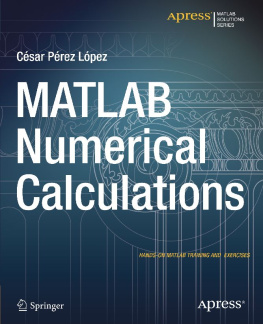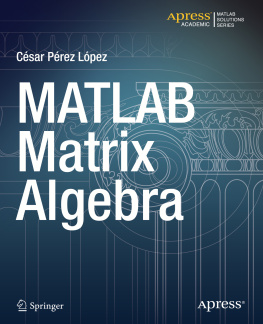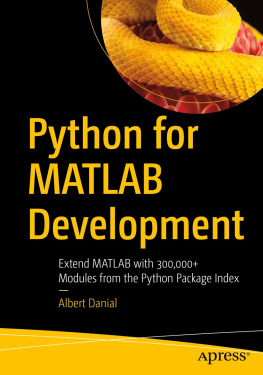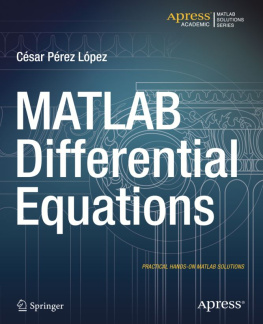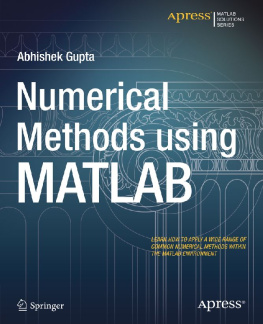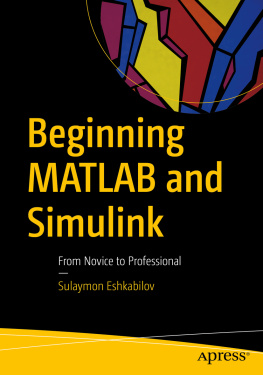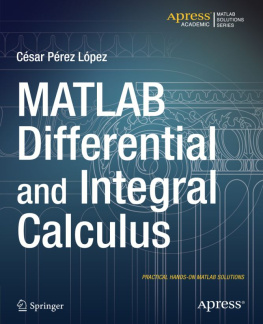César Pérez López - MATLAB Numerical Calculations
Here you can read online César Pérez López - MATLAB Numerical Calculations full text of the book (entire story) in english for free. Download pdf and epub, get meaning, cover and reviews about this ebook. year: 2014, publisher: Apress, genre: Computer. Description of the work, (preface) as well as reviews are available. Best literature library LitArk.com created for fans of good reading and offers a wide selection of genres:
Romance novel
Science fiction
Adventure
Detective
Science
History
Home and family
Prose
Art
Politics
Computer
Non-fiction
Religion
Business
Children
Humor
Choose a favorite category and find really read worthwhile books. Enjoy immersion in the world of imagination, feel the emotions of the characters or learn something new for yourself, make an fascinating discovery.
- Book:MATLAB Numerical Calculations
- Author:
- Publisher:Apress
- Genre:
- Year:2014
- Rating:5 / 5
- Favourites:Add to favourites
- Your mark:
MATLAB Numerical Calculations: summary, description and annotation
We offer to read an annotation, description, summary or preface (depends on what the author of the book "MATLAB Numerical Calculations" wrote himself). If you haven't found the necessary information about the book — write in the comments, we will try to find it.
MATLAB is a high-level language and environment for numerical computation, visualization, and programming. Using MATLAB, you can analyze data, develop algorithms, and create models and applications. The language, tools, and built-in math functions enable you to explore multiple approaches and reach a solution faster than with spreadsheets or traditional programming languages, such as C/C++ or Java. This book is designed for use as a scientific/business calculator so that you can get numerical solutions to problems involving a wide array of mathematics using MATLAB. Just look up the function you want in the book and you are ready to use it in MATLAB or use the book to learn about the enormous range of options that MATLAB offers.MATLAB Numerical Calculations focuses on MATLAB capabilities to give you numerical solutions to problems you are likely to encounter in your professional or scholastic life. It introduces you to the MATLAB language with practical hands-on instructions and results, allowing you to quickly achieve your goals. Starting with a look at basic MATLAB functionality with integers, rational numbers and real and complex numbers, and MATLABs relationship with Maple, you will learn how to solve equations in MATLAB, and how to simplify the results. You will see how MATLAB incorporates vector, matrix and character variables, and functions thereof. MATLAB is a powerful tool used to defined, manipulate and simplify complex algebraic expressions. With MATLAB you can also work with ease in matrix algebra, making use of commands which allow you to find eigenvalues, eigenvectors, determinants, norms and various matrix decompositions, among many other features. Lastly, you will see how you can write scripts and use MATLAB to explore numerical analysis, finding approximations of integrals, derivatives and numerical solutions of differential equations.What youll learn How to use MATLAB to work with numeric, vector, matrix and character variables. How to use MATLAB to work with matrix and vector functions, including all the standard matrix operations and decompositions. How to define and work with functions of one or more variables, recursive functions, and use loops and scripts in MATLAB. How MATLAB can be used to explore numerical analysis, finding approximations of integrals and derivatives, and numerical solutions of differential equations.Who this book is for This book is for anyone who wants to work in a practical, hands-on manner on numeric calculations in algebra or calculus problems with MATLAB. Youll already have a core understanding of undergraduate level calculus, algebra and linear algebra, and have access to an installed version of MATLAB, but no previous experience of MATLAB is assumed. Table of ContentsChapter 1 Introduction to MATLABChapter 2 Integers, Divisibility and Numbering SystemsChapter 3 Real and Complex ExpressionsChapter 4: Numeric VariablesChapter 5: Vectors and MatricesChapter 6: FunctionsChapter 7: Programming and Numerical Analysis MethodsChapter 8: Numerical Algorithms: Equations, Derivatives, Integrals and Differential Equations
César Pérez López: author's other books
Who wrote MATLAB Numerical Calculations? Find out the surname, the name of the author of the book and a list of all author's works by series.

